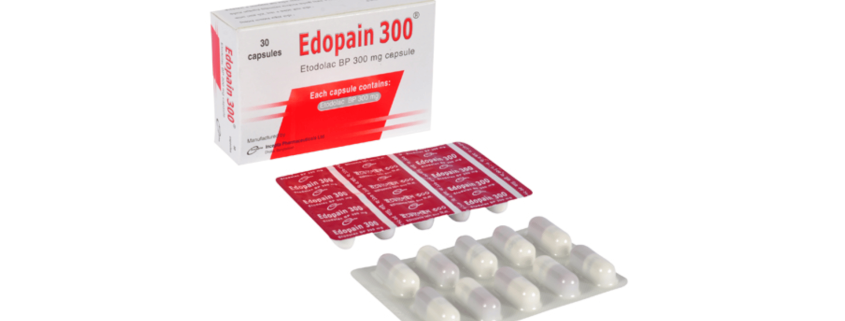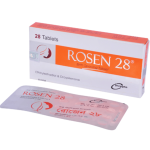Edopain(Etodolac)

Therapeutic Group: Analgesic, Anti Inflammatory
Presentation
Edopain 300: Each capsule contains Etodolac BP 300 mg.
Edopain 600 ER: Each extended release tablet contains Etodolac USP 600 mg.
Description
Etodolac is a nonsteroidal anti-inflammatory drug (NSAID) that exhibits anti-inflammatory, analgesic and antipyretic activities. The mechanism of action of Etodolac, like that of other NSAIDs related to prostaglandin synthesis inhibition.
Indications
For acute and long-term use in the management of signs and symptoms –
1. Osteoarthritis
2. Rheumatoid arthritis
For the management of acute pain
Acute gout
Dosage & Administration
Adults and over 18 years:
Edopain 300 capsule: 600 mg daily in 1-2 divided doses
Edopain 600 ER tablet: Once daily
Pediatric: Safety and effectiveness in pediatric patients below the age of 18 years have not been established.
Side Effects
The common side effects of Etodolac involve the gastrointestinal system. It can cause abdominal pain, constipation, diarrhea, dyspepsia, flatulence, heartburn, nausea, GI ulcers, vomiting. Other events including abnormal renal function, anemia, dizziness, edema, elevated liver enzymes, headaches, increased bleeding time, pruritis, rashes, tinnitus etc.
Precautions
Etodolac should be given with caution in patients with severe hepatic reactions, pre-existing asthma, fluid retention, hypertension or heart failure. If clinical sings and symptoms consistent with liver disease develop, or if systemic manifestations occur (e.g. eosinophilia, rash etc.), it should be discontinued.
Use in Pregnancy & Lactation
Pregnancy: There are no adequate and well-controlled studies in pregnant women. It should be use in pregnancy only if the potential benefit justifies the potential risk to the fetus.
Lactation: It is not known whether Etodolac is excreted in human milk. A decision should be made whether to discontinue nursing or to discontinue the drug taking into account the importance of the drug to the mother.
Drug Interaction
Reports suggest that NSAIDs may diminish the antihypertensive effect of ACE-inhibitors. This interaction should be given consideration in patients taking NSAIDs concomitantly with ACE-inhibitors. When Etodolac is administered with Aspirin, its protein binding is reduced, although the clearance of free Etodolac is not altered. The clinical significance of this interaction is not known; however, as with other NSAIDs, concomitant administration of Etodolac and Aspirin is not generally recommended because of the potential of increased adverse effects.
Over Dose
Symptoms following acute NSAID overdose are usually limited to lethargy, drowsiness, nausea, vomiting, and epigastric pain which are generally reversible with supportive care.
Storage
Do not store above 30°C. Keep away from light and out of the reach of children.
Commercial Pack
Edopain 300: Each box contains 3 blister strips of 10 capsules.
Edopain 600 ER: Each box contains 2 blister strips of 10 tablets.



